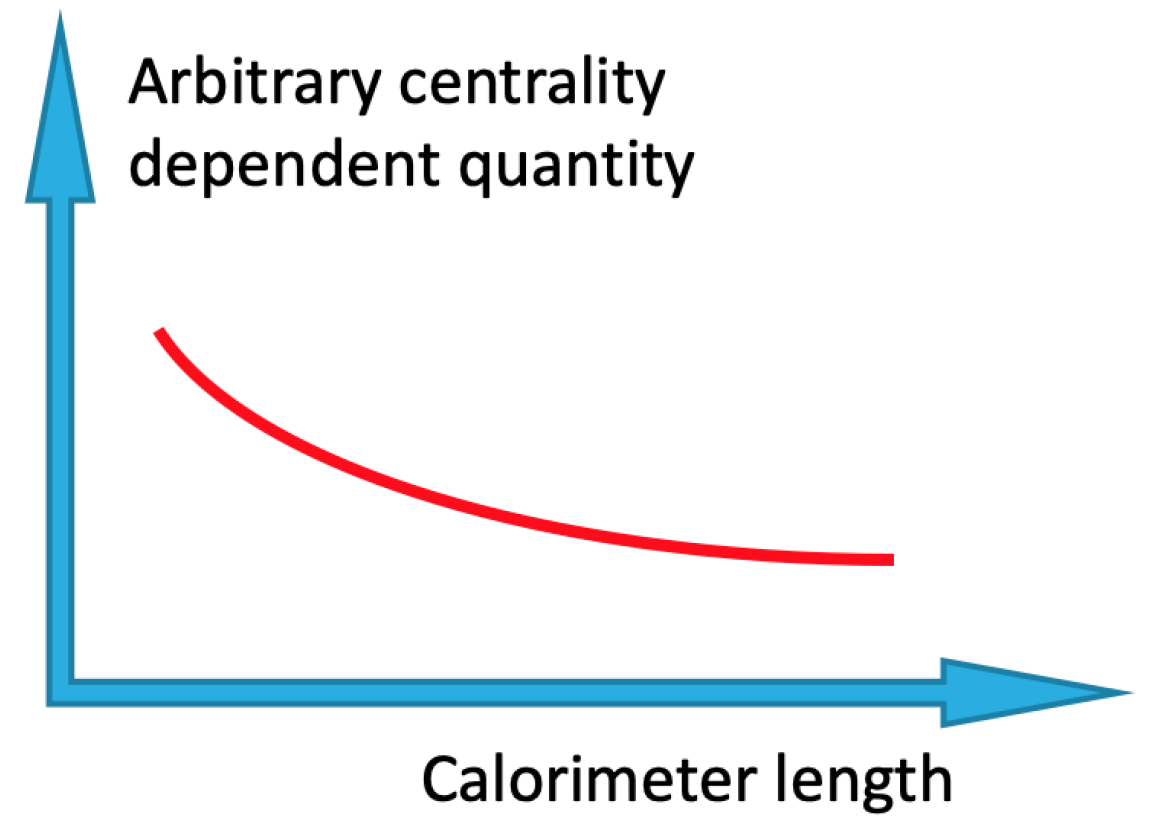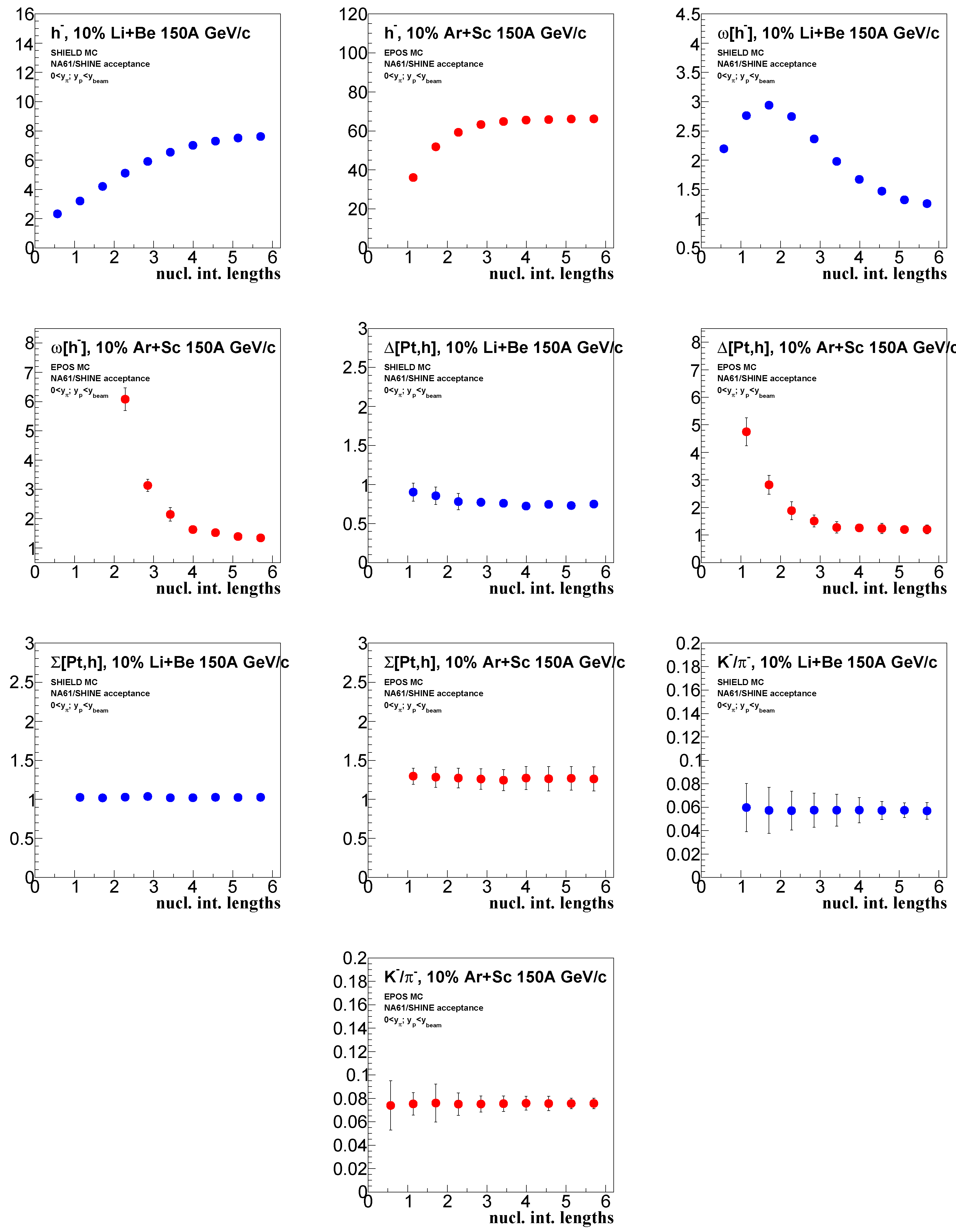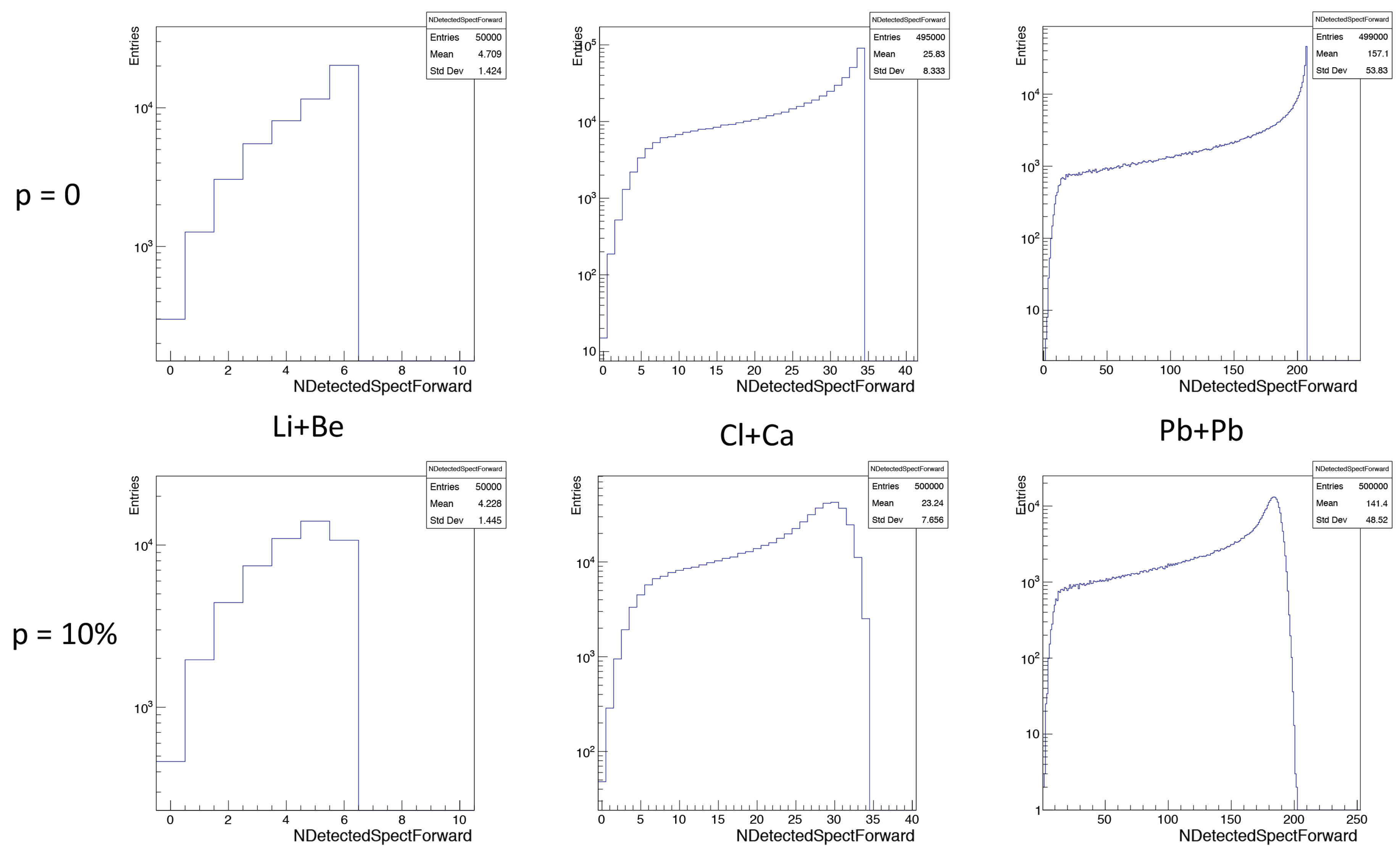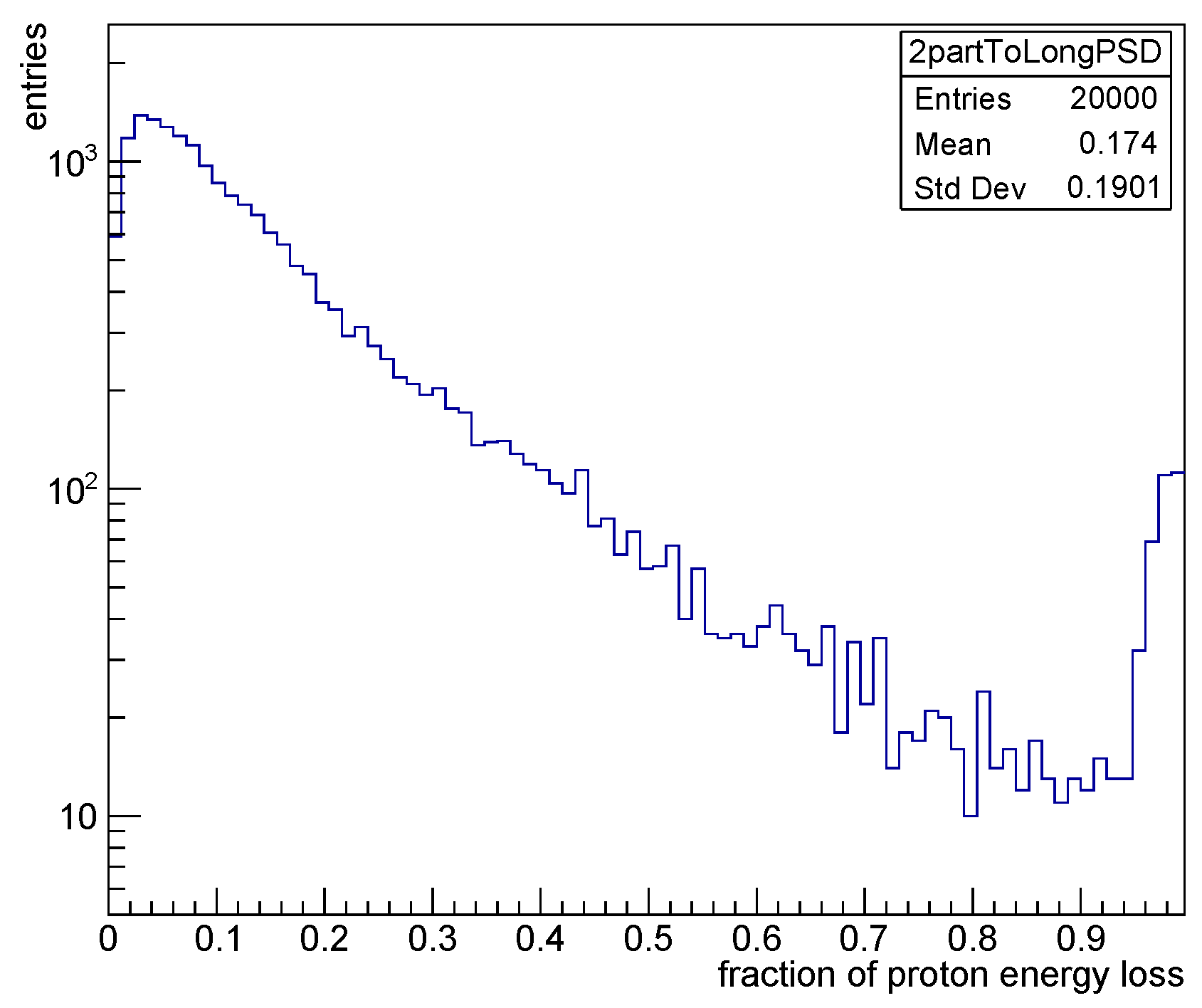1. Introduction
Fluctuation measures are considered to be an important tool in the search of the possible critical point of the strongly interacting matter. However, fluctuation quantities are sensitive to various effects along with the critical behavior [
1,
2,
3,
4] such as volume fluctuations [
5,
6], resonance decays [
7], beam and target material impurities [
8] and detector inefficiencies.
Experiments in relativistic heavy ion collisions use different techniques to reduce volume fluctuations by selecting centrality classes. The procedure aims to select events with a restricted number of particle production sources or volume. The centrality selection may be accomplished by measuring produced particle multiplicity in a specific rapidity interval along with energy of non-interacted nucleons-spectators by forward hadronic calorimeters. Although the multiplicity based approach introduces, a bias on any fluctuations due to correlations between multiplicities even in different acceptance windows. However, it is worth noting that this bias can be well reproduced and estimated by using MC generators.
Contrary to this, a solely spectators based centrality selection provides an unbiased method to restrict the collision volume. Technically, it can be accomplished only in fixed target experiments, as it is possible there to place a hadronic calorimeter exactly at the beam line. Nevertheless, such calorimeters suffer from hadronic shower energy leakages from the surface and have much lower resolution capabilities compared to multiplicity detectors. In this paper, we study an influence of the energy leakage from the calorimeter back surface on the average multiplicities and the multiplicity scaled variance and its dependency on the colliding system size.
2. Study with a Geant Calorimeter Model
The main motivation for this work was a study of how Projectile Spectator Detector (PSD) [
9] influences the measured quantities in the NA61/SHINE collaboration [
10]. PSD is a segmented modular hadronic calorimeter, which is used for triggering, centrality and event plane determination. The detector consists of 44 independent modules and each of them has 60 lead (16 mm) + scintillator (4 mm) layers. The total length of PSD is about 1.2 m, which corresponds to approximately 5.6 interaction lengths. A scheme of the NA61/SHINE setup and a photo of PSD are presented in
Figure 1.
Signals from 60 scintillators in each module are grouped by six, therefore, the design of PSD allows collecting information from ten independent areas along the beam axis inside the calorimeter. This makes it possible to study dependencies of different quantities on the calorimeter lengths by selecting centrality by a reduced number of scintillator groups. It is expected that any centrality sensitive measure will saturate at one point with an increase of calorimeter length (see
Figure 2). On such plot, the 0 limit corresponds to 0 centrality detector efficiency, an absence of centrality selection and to minimum bias events. The right limit is an absence of any energy leakage from the hadronic calorimeter backside.
Two MC datasets were generated with the GEANT4 [
11] PSD simulation for studying the energy leakage influence on different systems: 100,000 events of 150
A GeV/c
Li +
Be SHIELD MC [
12] and 40,000 events of 150
A GeV/c
Ar +
Sc EPOS 1.99 MC [
13].
Li was chosen instead of experimentally used
Be as the first one is stable and can be simulated by SHIELD MC. It was possible to compare two completely different MC generators as the studied effect was purely detector based. Moreover, it does not depend on the spectator transverse characteristics as we studied longitudinal shower propagation that is insensitive to a hit position. In each dataset, we selected centrality on the different length of the detector from ≈1.1 to 5.6 interaction lengths. The results for average multiplicities, multiplicity ratios and fluctuation quantities are presented in
Figure 3 for
Li +
Be and for
Ar +
Sc collisions.
Two main conclusions may be drawn from the results:
The 5.6 interaction lengths were not enough to eliminate the influence of backside energy leakage in light colliding systems (Li + Be) on volume fluctuations as the dependencies did not saturate. The middle size systems as Ar + Sc were much less prone to the effect. However, Ar + Sc data are more sensitive to energy leakage in case of a short calorimeter.
Mean multiplicities, scaled variance
[h] = (<h
> − <h>
)/<h> and strongly intensive
[Pt,h] [
14] were sensitive to the effect, while mean multiplicity ratios and another strongly intensive quantity
[Pt,h] showed steady behavior. The instability of
[Pt,h] contradicted the presumption that such quantities do not depend on the volume fluctuations. Therefore, it was clear that assumptions which lead to the construction of the strongly intensive measure
[Pt,h] [
14] are not fulfilled even in MC generators. Investigation of other measures sensitivities transcends the scope of this work.
3. Study within a Wounded Nucleon Model
A simple wounded nucleon model (WNM) was created to understand the unexpected sensitivity of light systems to the energy leak. Three different colliding systems were considered:
Li +
Be,
Cl +
Ca and
Pb +
Pb with 150
A GeV/c beam momentum (
17
A GeV). Nucleon density profiles were taken from [
16]. Nucleon core effect was not taken into account. Alpha clustering was not implemented as the goal of the study was to check how the sensitivity to the energy leakage depends on the number of nucleons in colliding systems. Inelastic nucleon–nucleon cross-section was taken equal to
mb. Multiplicity was introduced based on the number of wounded nucleons; in other words, each wounded nucleon produced a random number of charged particles, which were distributed according to a Poisson with
.
In the first version of the model, we introduce dcentrality selection based on the number of forward nucleon-spectators and a probability to lose each of them
p. Distributions of forward nucleon spectators for
and
are shown in
Figure 4.
The 10% of events with a lower number of detected forward nucleons spectators were selected as the most central ones. If the boundary between classes di not coincide with the boundary between integer numbers of forward spectators N, then a fraction of events with N + 1 forward spectators was taken to obtain exactly 10% of the whole data sample.
The dependencies of average event multiplicity and multiplicity scaled variance
[N] versus the probability to lose a forward spectator showed a striking difference (
Figure 5) in the sensitivity to detector efficiency between light system and heavy one (
Li +
Be and
Pb +
Pb). <N> and
[N] in Beryllium collisions became sensitive to the spectators lost already, then
p ≈ 3–4% contrary to Pb + Pb collisions where <N> and
[N] were steady to the effect until
p ≈ 70% and 30% respectively (see
Figure 6).
Unexpectedly, this simple model reproduced two important features: higher sensitivity of light systems for small energy loss and lower sensitivity for large fraction energy loss. Nevertheless, we are aware of the fact that the probability to lose a spectator is not a realistic model of a hadronic calorimeter. The next step was to introduce a realistic energy losd. For this goal a two-times longer (≈11.2 interaction length) GEANT4 model of PSD was used and a response on a 150 GeV/c proton beam was generated. We calculated and fitted a distribution of ratio between deposited by a proton energy in the first seven sections (≈3.9 int.l.) to the whole calorimeter (20 sections), as shown in
Figure 7. We used the obtained function to introduce a random energy loss of each forward spectator in the wounded nucleon model.
The 10% of the most central events were selected by the spectator deposited energy (see
Figure 8). <N> and
[N] were calculated and compared with the ideal case (without energy loses). The results are presented in
Table 1.
As shown, the effect is very tiny but nevertheless the lighter the system is the more sensitive it is. The size of the difference is probably a result of an absence of the energy resolution due to the calorimeter sandwich structure, as present in the GEANT4 simulation.
4. Conclusions
It was observed that the light nuclei systems as Li + Be are more sensitive to the energy leakage from the back side of hadronic calorimeters used for centrality determination in fixed target experiments compared to intermediate size systems as Ar + Sc. The probable reason is that in the light systems most of the forward energy is concentrated only in a few nucleons. Therefore, a single nucleon loss produces much bigger volume fluctuations than in a collision of heavy systems, which have a presence of more or less constant energy leakage in each collision. Nevertheless, more investigations are needed to reach the complete understanding of the phenomenon. Even though we succeeded in demonstrating the sensitivity of light systems in the framework of the wounded nucleon model with the probability of a spectator loss, the realistic energy loss simulation in the same model shows only a tiny effect on average multiplicity and scaled variance.
The future fixed target programs, which aim to study light nuclei colliding systems, have to pay attention that a longer calorimeter is needed to control the volume fluctuations for such reactions than for heavier ones.
Funding
This research was funded by the Russian Science Foundation grant number 17-72-20045 in a part of data analysis from MC generators (
Section 2) and the Russian Foundation for Basic Research grant number 18-32-01055 mol_a in a part of wounded nucleon model analysis (
Section 3).
Acknowledgments
We would like to thank Sergey Morozov, Marina Golubeva and the PSD group for providing the calorimeter and the SHIELD MC simulations; Justyna Monika Cybowska for providing the EPOS MC simulation; and Evgeny Andronov, Marek Gazdzicki, Peter Seyboth and the NA61/SHINE collaboration for discussions leading to this article.
Conflicts of Interest
The author declares no conflict of interest. The funders had no role in the design of the study; in the collection, analyses, or interpretation of data; in the writing of the manuscript, or in the decision to publish the results.
References
- Luo, X. Exploring the QCD Phase Structure with Beam Energy Scan in Heavy-ion Collisions. Nucl. Phys. A 2016, 956, 75–82. [Google Scholar] [CrossRef]
- Vovchenko, V.; Anchishkin, D.V.; Gorenstein, M.I.; Poberezhnyuk, R.V.; Stoecker, H. Critical fluctuations in models with van der Waals interactions. Acta Phys. Pol. Supp. 2017, 10, 753–758. [Google Scholar] [CrossRef]
- Luo, X.; Xu, N. Search for the QCD Critical Point with Fluctuations of Conserved Quantities in Relativistic Heavy-Ion Collisions at RHIC: An Overview. Nucl. Sci. Tech. 2017, 28, 112. [Google Scholar] [CrossRef]
- Gazdzicki, M.; Seyboth, P. Search for critical behavior of strongly interacting matter at the CERN Super Proton Synchrotron. Acta Phys. Pol. B 2016, 47, 1201–1236. [Google Scholar] [CrossRef]
- Luo, X.; Xu, J.; Mohanty, B.; Xu, N. Volume Fluctuation and Autocorrelation Effects in the Moment Analysis of Net-proton Multiplicity Distributions in Heavy-Ion Collisions. J. Phys. G Nucl. Part. Phys. 2013, 40, 105104. [Google Scholar] [CrossRef]
- Gorenstein, M.; Gazdzicki, M. Strongly Intensive Quantities. Phys. Rev. C 2011, 84, 014904. [Google Scholar] [CrossRef]
- Bluhm, M.; Nahrgang, M.; Bass, S.A.; Schäfer, T. Impact of resonance decays on critical point signals in net-proton fluctuations. Eur. Phys. J. C 2017, 77, 210. [Google Scholar] [CrossRef]
- Banas, D.; Kubala-Kukuś, A.; Rybczyński, M.; Stabrawa, I.; Stefanek, G. Influence of target material impurities on physical results in relativistic heavy-ion collisions. Eur. Phys. J. Plus 2019, 134, 44. [Google Scholar] [CrossRef]
- Golubeva, M. [NA61/SHINE Collaboration] Hadron Calorimeter (Projectile Spectator Detector—PSD) of NA61/SHINE experiment at CERN. KnE Energy Phys. 2018, 3, 379–384. [Google Scholar] [CrossRef]
- Abgrall, N. [NA61/SHINE Collaboration] NA61/SHINE facility at the CERN SPS: Beams and detector system. J. Instrum. 2014, 9, P06005. [Google Scholar] [CrossRef]
- Agostinellia, S.; Allison, J.; Amako, K.; Apostolakis, J.; Araujo, H.; Arcelmx, P.; Asaig, M.; Axen, D.; Banerjee, S.; Barrand, G.; et al. Geant4—A simulation toolkit. Nucl. Instrum. Methods Phys. Res. Sect. A 2003, 506, 250–303. [Google Scholar] [CrossRef]
- Dementyev, A.; Sobolevsky, N. SHIELD. Available online: www.inr.troitsk.ru/shield/introd-eng.html (accessed on 23 May 2019).
- Pierog, T.; Ulrich, R. EPOS 1.99 in CRMC. Available online: web.ikp.kit.edu/rulrich/crmc.html (accessed on 23 May 2019).
- Gazdzicki, M.; Gorenstein, M.I.; Mackowiak-Pawlowska, M. On Normalization of Strongly Intensive Quantities. Phys. Rev. C 2013, 88, 024907. [Google Scholar] [CrossRef]
- NA61/SHINE Collaboration. Acceptance Maps Used in the Paper: Multiplicity and Transverse Momentum Fluctuations in Inelastic Proton-Proton Interactions at the CERN Super Proton Synchrotron. Available online: edms.cern.ch/document/1549298/1 (accessed on 23 May 2019).
- De Vries, H.; De Jager, C.W.; De Vries, C. Nuclear Charge Density Distributions Parameters from Elastic Electron Scattering. At. Data Nucl. Data Tables 1987, 36, 495–536. [Google Scholar] [CrossRef]
© 2019 by the author. Licensee MDPI, Basel, Switzerland. This article is an open access article distributed under the terms and conditions of the Creative Commons Attribution (CC BY) license (http://creativecommons.org/licenses/by/4.0/).













